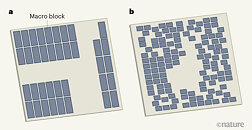Friday, June 11th 2021
AI-Designed Microchips Now Outperform Human-Designed Ones
A recent Google study led by Mirhoseini et al. and published in Nature details how AI can be leveraged to improve upon semiconductor design practices currently employed - and which are the result of more than 60 years of engineering and physics studies. The paper describes a trained machine-learning 'agent' that can successfully place macro blocks, one by one, into a chip layout. This agent has a brain-inspired architecture known as a deep neural network, and is trained using a paradigm called reinforcement learning - where positive changes to a design are committed to memory as possible solutions, while negative changes are discarded, effectively allowing the neural network to build a decision-tree of sorts that's optimized every step of the way.
The AI isn't applied to every stage of microchip design as of yet, but that will surely change in years to come. For now, the AI is only being employed in the chip floorplanning stage of microchip production, which is actually one of the more painstaking ones. Essentially, microchip designers have to place macro blocks on their semiconductor designs - pre-made arrangements of transistors whose placement relative to one another and to the rest of the chips' components are of seminal importance for performance and efficiency targets. Remember that electric signals have to traverse different chip components to achieve a working semiconductor, and the way these are arranged in the floorplanning stage can have tremendous impact on performance characteristics of a given chip. Image A, below, showcases the tidy design a human engineer would favor - while image B showcases the apparently chaotic nature of the AI's planning.While floorplanning carried out by human designers is a painstakingly long process that can take weeks or months between architecture iterations, the AI described in the study can achieve designs that are better compared to human specialist-designed ones in under six hours - and immense amount of time savings, with added performance and power improvements also to be considered, that could allow for much shorter development times for microchips. The AI has even shown ability to solve placement issues it never has dealt with before - the study explains that the system was trained on over 10,000 microchip designs, and that when faced with a selection of macro blocks to arrange in the floorplanning stage of microchip design, novelty iterations of components were found to outperform those designed by teams of human engineers.
Source:
Nature
The AI isn't applied to every stage of microchip design as of yet, but that will surely change in years to come. For now, the AI is only being employed in the chip floorplanning stage of microchip production, which is actually one of the more painstaking ones. Essentially, microchip designers have to place macro blocks on their semiconductor designs - pre-made arrangements of transistors whose placement relative to one another and to the rest of the chips' components are of seminal importance for performance and efficiency targets. Remember that electric signals have to traverse different chip components to achieve a working semiconductor, and the way these are arranged in the floorplanning stage can have tremendous impact on performance characteristics of a given chip. Image A, below, showcases the tidy design a human engineer would favor - while image B showcases the apparently chaotic nature of the AI's planning.While floorplanning carried out by human designers is a painstakingly long process that can take weeks or months between architecture iterations, the AI described in the study can achieve designs that are better compared to human specialist-designed ones in under six hours - and immense amount of time savings, with added performance and power improvements also to be considered, that could allow for much shorter development times for microchips. The AI has even shown ability to solve placement issues it never has dealt with before - the study explains that the system was trained on over 10,000 microchip designs, and that when faced with a selection of macro blocks to arrange in the floorplanning stage of microchip design, novelty iterations of components were found to outperform those designed by teams of human engineers.

40 Comments on AI-Designed Microchips Now Outperform Human-Designed Ones
www.cs.utah.edu/~elb/folklore/mel.html
Most programmers would run-in-fear if their job-description echoed Mels...but, because of standardized multi-platform languages, we can all concentrate on the bigger-picture "
While Mel probably never managed more than 10k lines of code in his entire life, high-level programming has allowed us to penetrate that new level of program complexity (modern elite programmers are familiar with hundreds of thousands of lines, whil even the worst can handle Mel-levels!)
I'm sure if we could reach some compromise for the workaholic Mels out there, We could all benefit from new waves of AI-optimized automation :D
ALARM! ALARM! ALARM!
thedailywtf.com/articles/No,_We_Need_a_Neural_Network
He did it using wing bark. No Quack.
Or at least... I don't have the depth to imagine it not being that way. Pretty much everything else is bound by this. You can have breakthroughs that advance things rapidly - spikes in that curve, if you will, but all you're doing is losing restrictions. The one remains... material demands are inescapable. I'm not sure how an AI ever gets quite to the efficiency to spin off in the way some people think that it will.
There's just a lot of here to there involved. A HUGE gap between now and a machine with that capability. It would need to be plugged into a crazy sci-fi power system, have access to all of this stuff. Hardware man. This stuff runs on hardware. We would still need to line a lot up ourselves for anything like that to ever exist. About as likely as a true free energy device.
Because humans can't do that either :pYeah except when you realize that AI already has a plan for us! Imagine a near "perfect future" ala the Matrix combined with ~
www.imdb.com/title/tt1677720/
;)